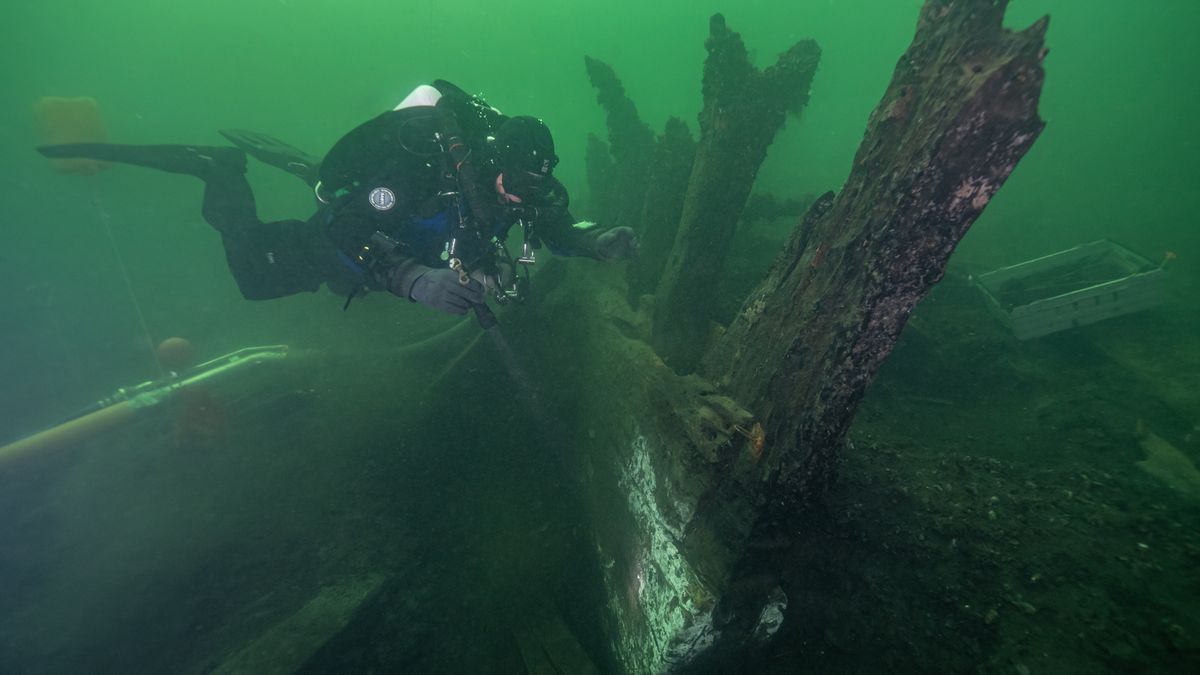A 15th-century royal warship resting off the coast of Sweden once served as a “floating castle” for an intrepid king, according to new underwater investigation that revealed cannons, handguns, crossbows and the vessel’s stern superstructure.
The new finds on the wreck of the Gribshunden — the flagship of King Hans (or John) of Denmark until it sank in 1495 — show the vessel plied the seas as a fearsome ship of war armed with dozens of guns and packed with soldiers.
It’s thought that the Gribshunden was armed with up to 90 early cannons, although they were much smaller than the ship-smashing cannons of the late 16th century, and that they were complemented by armored soldiers firing handguns and crossbows from the ship’s upper deck, forecastle and sterncastle — the tall superstructures built at each end of the ship.
The 115-foot-long (35 meters) wooden ship was one of the first vessels designed to carry artillery. It also utilized the new “carvel” shipbuilding technique, imported to the Baltic from the Mediterranean, of joining the planks of the hull edge to edge on a wooden frame instead of overlapping them in “lapstrakes.”
Related: $17 billion shipwreck near Colombia is remarkably preserved, new photos reveal
That meant the Gribshunden could be built larger and stronger than ships with lapstrakes, and so it could carry more in heavier seas.
“This is kind of a new technology,” Brendan Foley, a maritime archaeologist at Lund University in Sweden who is leading the latest excavations, told Live Science. “It was designed to carry artillery, and King Hans uses the ship in a way that no other king does.”
Royal flagship
From the mid-1480s, Hans frequently journeyed on the Gribshunden throughout his realm, often surrounded by a large royal fleet, Foley said, adding that the ship was intended to intimidate the king’s rivals.
The son of the previous Danish king, Hans ruled Denmark from 1481 and gained the crown of Norway in 1483, but Sweden didn’t submit to his rule until 1497.
“His realm is Denmark and Norway, and he’s trying to get Sweden to rejoin the Nordic Union,” Foley said. “So Hans is sailing around on this ship all the time.” (The Nordic Union of Denmark, Norway and Sweden was also called the Kalmar Union, after the town in Sweden where it was agreed in 1397.)
Hans embarked on the Gribshunden (which means “Griffin dog,” although it originally seems to have been called “Griffon”) for negotiations at Kalmar in 1495 when the ship mysteriously sank, supposedly after a fire broke out, at an anchorage just offshore near the town of Ronneby.
The king and his retinue were onshore at the time, but a witness to the disaster (opens in new tab) said many of the roughly 150 men onboard were killed.
Many of the ship’s guns were probably salvaged soon after the sinking, Foley said; the latest excavations found only 14 gun carriages near the stern, but many more were likely situated near the bow.
A peculiarity of the eastern Baltic Sea is that it’s too cold for infestations of shipworm (which is not a worm but a mollusk, Teredo navalis). Because of that, the wooden gun carriages are still intact, although the iron guns have rusted away, he said.
But there was no sign of fire, so the ship probably sank quickly after being holed below the waterline, possibly because its stores of gunpowder had exploded. “It’s one of the first ships carrying gunpowder, so they probably hadn’t worked out standard operating procedures for safety,” Foley said.
Related: Shackleton’s Endurance shipwreck teeming with extreme creatures
Floating castle
Local divers rediscovered the wreck of the Gribshunden near Ronneby in the 1970s, beneath about 33 feet (10 m) of water. It was identified in 2013, and in 2015, archaeologists recovered several artifacts, including the figurehead of a person clutched in the jaws of a dog or dragon, Live Science reported at the time.
Foley led dives to the wreck in August and September, during which the team recovered more artifacts and captured three-dimensional data for a digital reconstruction.
The wreck is considered a proxy for the ships from the Age of Exploration, such as those of Christopher Columbus and Vasco da Gama, which were built at about the same time but are now lost. “Nothing else like this has been found,” Foley said.
The combination of guns and crossbows, as well as the remnants of shirts of mail armor that were also found, show the transition from earlier weapons to gunpowder, he added.
The larger ship’s guns were mounted on swivels within their wooden carriages and fired projectiles about the size of golf balls. Meanwhile, the handguns were very simple — about 16 inches (40 centimeters) long, with projectiles like musket balls that were fired by touching a match to a hole in the back. “They were basically like a small cannon,” Foley said.
Fritz Jürgens, a maritime archaeologist at Kiel University in Germany isn’t involved in the study of the Gribshunden, but he’s leading research into a rare 400-year-old ship discovered in the outer stretches of the Trave River in the western Baltic. He noted that the Gribshunden is the oldest carvel-built ship ever found in the Baltic and one of the oldest purpose-built warships ever discovered.
“In the Middle Ages and in the later Hanseatic period [when a trading bloc dominated the Baltic, from the 13th to 17th centuries], they took normal cargo ships and put archers on it,” Jürgens said. “But the Gribshunden had artillery on the forecastle and sterncastle — it was specifically built for war.”
Originally published on Live Science.
Stay connected with us on social media platform for instant update click here to join our Twitter, & Facebook
We are now on Telegram. Click here to join our channel (@TechiUpdate) and stay updated with the latest Technology headlines.
For all the latest For Top Stories News Click Here

